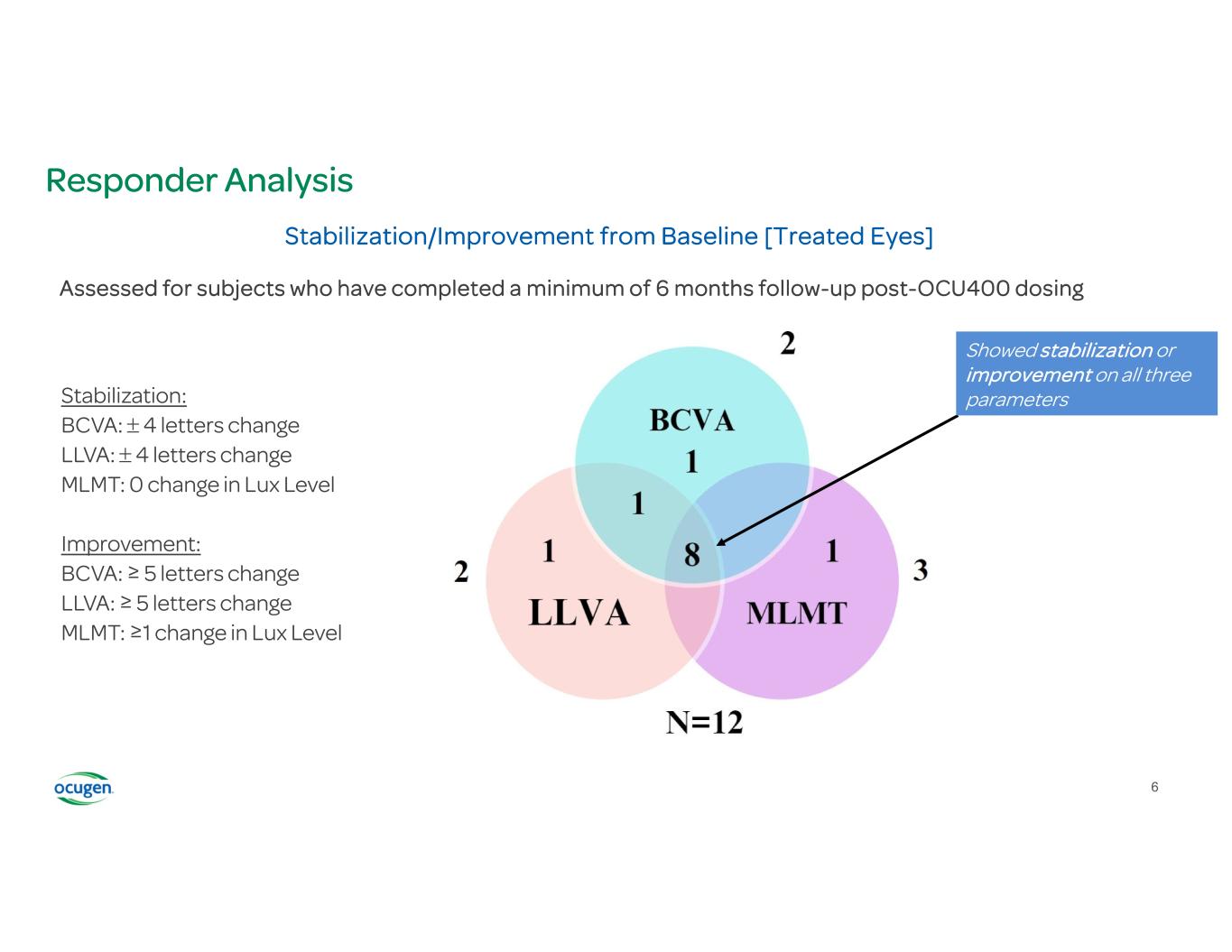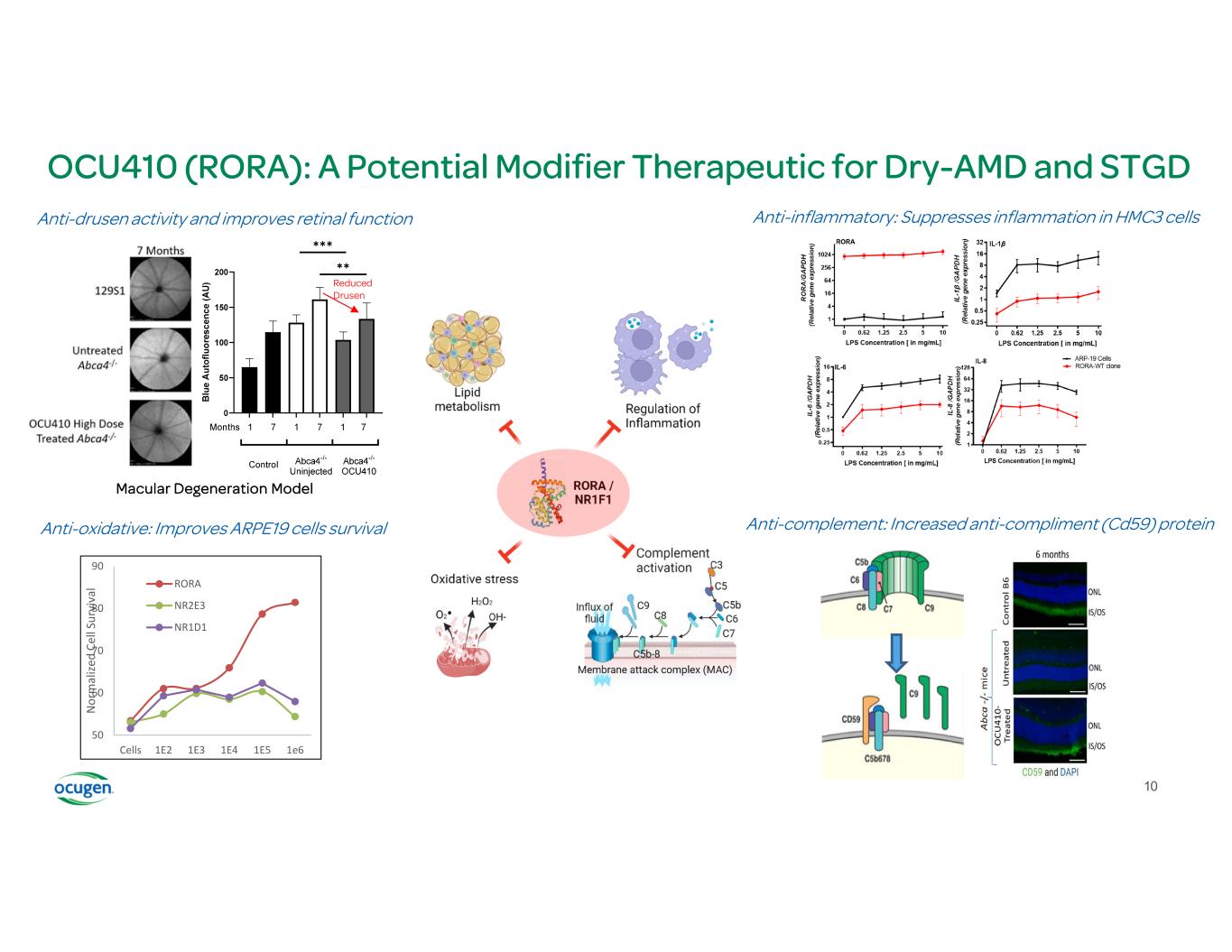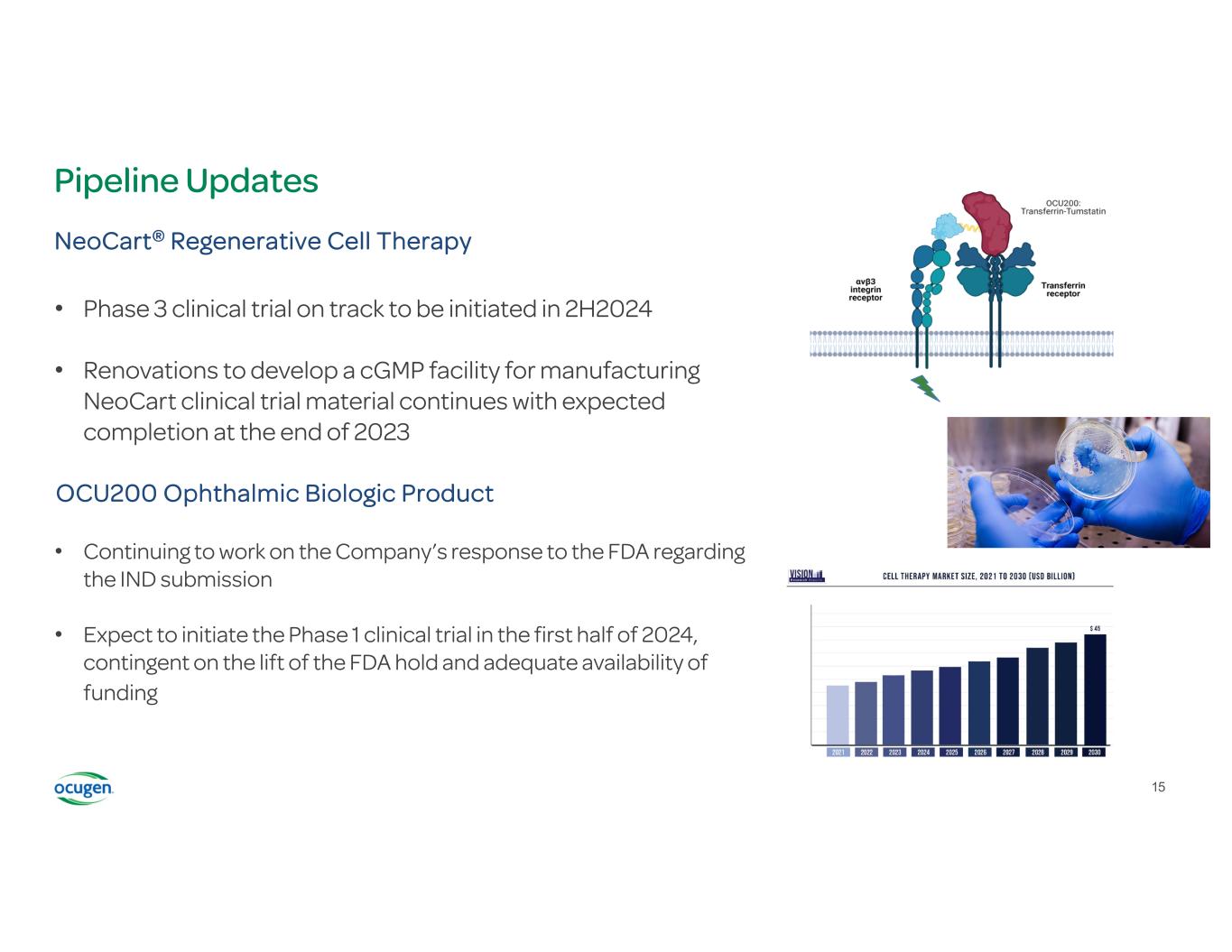
Courageous Innovation 3Q 2023 Business Update November 9, 2023 NASDAQ: OCGN

2 This presentation contains forward-looking statements within the meaning of The Private Securities Litigation Reform Act of 1995, which are subject to risks and uncertainties. We may, in some cases, use terms such as “predicts,” “believes,” “potential,” “proposed,” “continue,” “estimates,” “anticipates,” “expects,” “plans,” “intends,” “may,” “could,” “might,” “will,” “should,” or other words that convey uncertainty of future events or outcomes to identify these forward-looking statements. Such statements include, but are not limited to, statements regarding our clinical development activities and related anticipated timelines. Such statements are subject to numerous important factors, risks, and uncertainties that may cause actual events or results to differ materially from our current expectations. These and other risks and uncertainties are more fully described in our periodic filings with the Securities and Exchange Commission (SEC), including the risk factors described in the section entitled “Risk Factors” in the quarterly and annual reports that we file with the SEC. Any forward-looking statements that we make in this presentation speak only as of the date of this presentation. Except as required by law, we assume no obligation to update forward-looking statements contained in this presentation whether as a result of new information, future events, or otherwise, after the date of this presentation. Forward-Looking Statements

3 2023/2024: Updated Anticipated Timing on Milestones OCU500 NeoCart® OCU400 OCU410ST OCU200 3Q 2H244Q NIAID Selection Initiate Phase 3 trial Initiate Phase 3 trial for RP* Initiate Phase 1 trial Clinical trial update Initiate Phase 1/2 trial OCU410 *The Company will be expanding the OCU400 Phase 3 study for LCA patients in the latter part of 2024 based on Phase 1/2 study results in LCA patients and alignment with the FDA 1H24 Initiate Phase 1/2 trialIND cleared by FDA IND cleared by FDA Initiate clinical trial cGMP qualification Clinical trial update Clinical trial update Clinical trial update cGMP facility completion

OCU400 Clinical Program A Phase 1/2 Study to Assess the Safety and Efficacy of OCU400 for Retinitis Pigmentosa associated with NR2E3 and RHO mutations and Leber Congenital Amaurosis with mutation(s) in CEP290 gene Clinical Trials.gov Identifier: NCT05203939 Safety of subretinal administration of OCU400 Immune responses Systemic Distribution Best Corrected Visual Acuity (BCVA) Multi-Luminance Mobility Test (MLMT) Low Luminance Visual Acuity (LLVA) Primary: Safety Exploratory: Efficacy 4 4

Retinitis Pigmentosa (RP) and Leber Congenital Amaurosis (LCA)— Unmet need and Treatment Benefit Target • Inherited retinal diseases (IRDs), such as RP and LCA, are a group of heterogenous genetic disorders that affect the retina, the light-sensitive tissue at the back of the eye • IRDs often lead to a gradual loss of vision over time and can ultimately result in blindness • Stabilization of vision is crucial for patients with RP and LCA due to the progressive and degenerative nature of these diseases • Preservation of remaining vision, slowing disease progression, or improving the vision can significantly impact the lives of patients. Such outcomes can not only enhance the quality of life for affected individuals but also provide hope that future treatments could ultimately lead to vision restoration. • Comprehensive care, early diagnosis, and access to emerging therapies are essential components of a strategy to stabilize vision in RP and LCA patients 5

Responder Analysis Stabilization/Improvement from Baseline [Treated Eyes] Showed stabilization or improvement on all three parametersStabilization: BCVA: 4 letters change LLVA: 4 letters change MLMT: 0 change in Lux Level Improvement: BCVA: ≥ 5 letters change LLVA: ≥ 5 letters change MLMT: ≥1 change in Lux Level Assessed for subjects who have completed a minimum of 6 months follow-up post-OCU400 dosing 6

Encouraging Results from OCU400 Phase 1/2 Clinical Trial Update Results suggest gene modifier gene therapy has potential benefits in broader RP and LCA patients • OCU400 continues to demonstrate a favorable safety and tolerability profile • Clinical study update suggests continued positive trends in Best-Corrected Visual Acuity (BCVA) and Multi- Luminance Mobility Testing (MLMT), as well as positive trends in Low-Luminance Visual Acuity (LLVA) among treated eyes • 83% (10/12) of subjects demonstrated stabilization or improvement in the treated eye either on BCVA or LLVA or MLMT scores from baseline • 75% (9/12) of subjects demonstrated stabilization or improvement in treated eyes in MLMT scores from baseline • 86% (6/7) of RHO mutation subjects experienced either stabilization or improvement in MLMT scores from baseline, among which 29% (2/7) demonstrated 3 Lux luminance level improvement • Treatment effect in RHO patients—a disease affecting more than 10,000 people in the U.S. alone– supports the gene-agnostic mechanism of action of OCU400 7

Continued Momentum in Progressing OCU400 Phase 1/2 Trial • Completed dosing adult RP patients in the dose-escalation and dose-expansion portions of the trial • Completed dosing three LCA patients including a pediatric patient • Planning to initiate Phase 3 trial for the treatment of RP in early 2024 following FDA concurrence on study design • Expecting to expand the OCU400 Phase 3 clinical trial for LCA patients in the second half of 2024 based on Phase 1/2 clinical trial results in LCA patients and alignment with FDA 8

* As demonstrated in Peak scotopic B-wave amplitudes. N≥5 biological replicates Advancement from recently approved therapies for GA: Potential to address limitations of recently approved therapies for GA focused only on the complement system, including: • Patient Compliance Frequent intravitreal injections (~6-12 doses per year) • Observed Structural Impact Limited effect of GA lesion growth rate • Safety Considerations 12% of patients experienced nAMD when therapy is administered every month for two years (Syfovre®) OCU410 Phase 1/2 Study Currently Underway Limited options for dAMD, presenting significant unmet medical need • U.S.: 10M (GA: 1M) • Worldwide: 266M Distinct 4-Way MOA: Addresses multiple regulator pathways involved with the disease including: • Lipid Metabolism • Regulation of Inflammation • Oxidative Stress • Membrane Attack Complex (Complement) Optimal Delivery and Durability: • A single subretinal injection designed to eliminate patient compliance concerns and the treatment burden associated with multiple injections Improved Retinal function: • Improved photoreceptor function in OCU410 treated eyes with all doses* The potential for a one-time curative therapy with a single sub-retinal injection to address the unmet needs and treatment burden in patients with dAMD OCU410 (RORA): A Single-Injection Approach to Addressing Unmet Needs in dAMD BEYOND the Complement System 9

50 60 70 80 90 1e61E51E41E31E2Cells N or m al iz ed C el l S ur vi va l RORA NR2E3 NR1D1 Anti-oxidative: Improves ARPE19 cells survival Anti-complement: Increased anti-compliment (Cd59) protein Anti-inflammatory: Suppresses inflammation in HMC3 cellsAnti-drusen activity and improves retinal function ✱✱ ✱✱✱ Macular Degeneration Model Reduced Drusen OCU410 (RORA): A Potential Modifier Therapeutic for Dry-AMD and STGD 10

OCU410 Program Overview https://clinicaltrials.gov/study/NCT06018558?cond=Geographic%20atrophy&rank=2 11 • Assess the safety and efficacy of OCU410 in subjects with Geographic Atrophy (GA) secondary to dry Age-Related Macular Degeneration (AMD) • Single, unilateral subretinal injection using a modifier gene therapy platform • 63 adult subjects • Mild to moderate disease presentation 2 Inclusion Criteria: • Aged 50 or older • BCVA of ≈ 24 letter or more using ETDRS chart • Total GA area ≥2.5 and ≤17.5 mm^2 Exclusion Criteria: • Previous treatment with a gene-therapy or cell therapy product • History or current evidence of exudative (“wet”) AMD 3 41 Dose Escalation: • 3+3 design with a low, medium, and high dose cohort Dose Expansion: • Expansion using a 1:1:1 design, randomizing subjects to either two treatment groups/dose levels or one control group Study Objective and Modality Study Population Inclusion/Exclusion Criteria Overall Strategy

OCU410ST: Received ODD for ABCA4-Associated Retinopathies: Stargardt, Retinitis Pigmentosa 19(RP19) & Cone-rod Dystrophy 3(CORD3) ABCA4-associated retinopathies—Genetic Rare Disease • ABCA4 gene produces an ATP-binding cassette (ABC) superfamily transmembrane protein involved in clearance of all-trans-retinal aldehyde, a byproduct of the retinoid cycle, from photoreceptor cells • Mutation in ABCA4 gene results in Stargardt disease. Different ABCA4 alleles have been identified to cause other retinopathies such as cone-rod dystrophy type 3 (CORD 3), retinitis pigmentosa type 19 (RP 19) No treatment options exist • U.S.: 44,000 patients Modifier gene therapy platform addresses shortcomings of current approaches • AAV delivery platform delivers the RORA (RAR Related Orphan Receptor A) • Broad-spectrum, gene-agnostic approach • Potential one-time, curative therapy with a single sub-retinal injection Phase 1/2 underway 12

• Assess the safety and efficacy of OCU410ST in subjects with Stargardt disease • Single, unilateral subretinal injection using a modifier gene therapy platform • 42 subjects (30 adults and 12 pediatrics) • Mild to moderate disease presentation 2 3 41 Dose Escalation: • 3+3 design with a low, medium, and high dose cohort Dose Expansion: • Expansion using a 1:1:1 design, randomizing subjects to either two treatment groups or control group Study Objective and Modality Study Population Inclusion/Exclusion Criteria Overall Strategy Adult Inclusion Criteria: • Aged 18-65 • Total lesion area ≤18 𝒎𝒎𝟐 • BCVA of 50 ETDRS letters or less Pediatric Inclusion Criteria: • Aged 6-17 • Total lesion area ≤18 𝒎𝒎𝟐 • BCVA of 35 ETDRS letters or more Exclusion Criteria: • Previous treatment with a gene-therapy or cell therapy product • Has genes that mimic Stargardt Disease like ELOVL4 or PROM1 OCU410ST Program Overview https://clinicaltrials.gov/study/NCT05956626?cond=Stargardt%20Disease&rank=4 13

OCU500 Selected for NIAID’s Project NextGen Covid-19 Clinical Trial OCU500 to expand vaccine options in fighting COVID-19 • NIAID Phase 1 clinical trials will evaluate the safety and immunogenicity of OCU500 using inhaled and intranasal routes of delivery • Collaborating with NIAID to initiate the clinical trials in early 2024 Inhalation technology as a differentiator • Multiple preclinical studies using Ocugen’s vector demonstrated vaccine-induced high neutralizing and effector responses • Clinical studies using a similar vector administered via the inhalation platform showed mucosal antibodies, systemic antibodies, and durable immune response up to 1 year with 1/5 of the dose compared to the same vaccine given via intramuscular administration • Inhaled method offers the potential for broad, durable protection from severe disease and reduction in transmission Strategic importance of government funding • First step in potentially expanding the platform to flu and other respiratory viral diseases and infections • Funding makes it possible to focus R&D and clinical resources on Ocugen’s first-in-class gene and cell therapies 14

Pipeline Updates NeoCart® Regenerative Cell Therapy • Phase 3 clinical trial on track to be initiated in 2H2024 • Renovations to develop a cGMP facility for manufacturing NeoCart clinical trial material continues with expected completion at the end of 2023 OCU200 Ophthalmic Biologic Product • Continuing to work on the Company’s response to the FDA regarding the IND submission • Expect to initiate the Phase 1 clinical trial in the first half of 2024, contingent on the lift of the FDA hold and adequate availability of funding 15

FinancialUpdate 16

Financial Update Nine months ended September 30, Three months ended September 30,Statement of Operations 2022202320222023 $32.5$30.1$15.6$6.3Research and development expense 28.226.87.59.1General and administrative expense 1.33.31.21.3Other income (expense), net $(59.4)$(53.6)$(21.9)$(14.2)Net loss $(0.28)$(0.22)$(0.10)$(0.06)Net loss per share of common stock — basic and diluted December 31, 2022September 30, 2023Balance Sheet Data $90.9$53.5Cash, cash equivalents, and investments $2.3$2.8Debt 221.6256.5Shares outstanding Unaudited; in millions, except per share amounts Certain amounts may not add due to rounding 17

Questions & Answers 18

19 Ocugen™ Vision Fully integrated, patient-centric biotech company focused on vaccines in support of public health and gene and cell therapies targeting unmet medical needs through Courageous Innovation


















